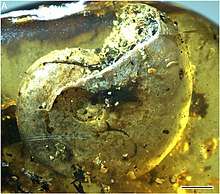Puzosia (Bhimaites)
Puzosia (Bhimaites) is a subgenus of desmoceratid ammonites with a subinvolute, mostly smooth, high whorled shell with convex or flat sides and frequent constrictions on the venter. It is included in the subfamily Puzosiinae and has been found in Upper Albian and Cenomanian sediments in Angola, South Africa, and southern India.
| Puzosia (Bhimaites) | |
|---|---|
 | |
| Juvenile Puzosia (Bhimaites) shell in Burmese amber | |
| Scientific classification | |
| Kingdom: | |
| Phylum: | |
| Class: | |
| Subclass: | |
| Order: | |
| Family: | |
| Genus: | |
| Subgenus: | Puzosia (Bhimaites) Matsumota, 1954 |
| Species [2] | |
| |
In 2019, a Bhimaites shell was found fossilized in a 99 million-year-old chunk of Burmese amber from Myanmar, marking the first known discovery of an ammonite preserved in amber. The ammonite's shell was presumably picked up and preserved after the resin fell off a tree and tumbled across the seashore.[3][4]
References
- Notes
- Sepkoski, Jack (2002). "Sepkoski's Online Genus Database". Retrieved 2014-05-28.
- "Paleobiology Database - Puzosia (Bhimaites)". Retrieved 2014-05-28.
- "This ancient sea creature fossilized in tree resin. How'd that happen?". Science & Innovation. 2019-05-13. Retrieved 2019-05-14.
- Dilcher, David; Wang, Bo; Zhang, Haichun; Xia, Fangyuan; Broly, Pierre; Kennedy, Jim; Ross, Andrew; Mu, Lin; Kelly, Richard (2019-05-10). "An ammonite trapped in Burmese amber". Proceedings of the National Academy of Sciences. 116 (23): 11345–11350. doi:10.1073/pnas.1821292116. ISSN 0027-8424. PMC 6561253. PMID 31085633.
- Bibliography
- Arkell, et al., 1957. Mesozoic Ammonoidea; Treatise on Invertebrate Paleontology, Part L. Geological Society of America and University of Kansas Press.
This article is issued from Wikipedia. The text is licensed under Creative Commons - Attribution - Sharealike. Additional terms may apply for the media files.